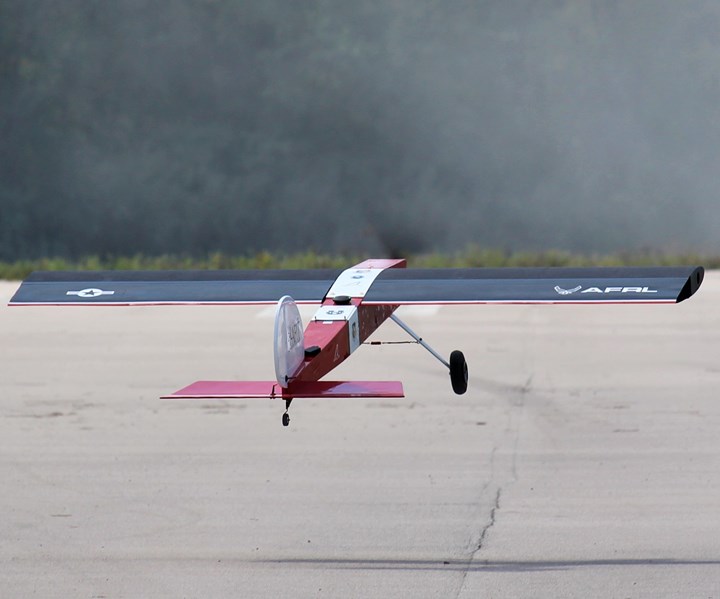AFRL camber morphing wing takes flight
Smooth composite skin enables active re-contour of up to 6% and fuel savings of 10%.

The Air Force Research Laboratory (AFRL, Wright-Patterson Air Force Base, Ohio, U.S.) recently completed the successful flight demonstration of a game-changing camber morphing wing technology that could significantly increase aircraft range and performance.
The AFRL-developed Variable Camber Compliant Wing (VCCW) is capable of changing shape to improve aerodynamic performance and morph itself to various flight conditions and missions. Wing camber, or the shape of a wing surface, is a fundamental element of aerodynamic flight. Conventional wings with discrete hinged control surfaces have greater drag, whereas wings with a smooth camber are efficient and maneuverable. The ability to morph the wing according to aerodynamic conditions would give an aircraft increased lift when needed without a weight penalty — typically at takeoff and landing — and greater fuel-efficiency and maneuverability when in flight.
This flight experiment demonstrated the second iteration of the VCCW, a smaller, more compact version than the first, which was used primarily in wind tunnel experiments. This eight-foot wing was designed to be flown on a commercial-off-the-shelf remotely controlled aircraft, simulating an unmanned air vehicle. During the series of flights, held in September and October 2019, the wing was flown at low speeds, completing a number of maneuvers and demonstrating active shape control for optimized drag reduction and increased agility.
Single-piece, composite skin
The VCCW features smooth and continuous skin construction, which not only reduces noise by eliminating sharp surfaces and gaps, but improves aerodynamic performance as well. According to Dr. James Joo, AFRL Advanced Structural Concepts team lead and VCCW program manager, the improved aerodynamics translates into potentially significant fuel savings.
“Early estimates show VCCW technology saving aircraft fuel consumption by 10 percent,” said Joo. “This was one of our main goals, and it fits the Air Force’s efforts to reduce overall energy costs.”
According to a :
“The wing can actively re-contour the airfoil camber up to 6% and the entire skin is seamless, continuous, and made of a single-piece, non-stretchable composite skin. Smooth conformal shape of the wing is attained by distributed elastic deformation from the underlying compliant mechanism and 3D shape change is also capable through variation of camber along the spanwise direction using a distributed actuation system along the span. Single actuation control for both leading and trailing edge deflection is another very unique aspect of VCCW compared to previous technologies. It was fabricated using advanced manufacturing technology enabling a solution that is lightweight, low power, and low cost.”
Advancing flexible wing technology
Jared Neely, AFRL research engineer and designer of the morphing wing, called this demonstration an important step in advancing flexible wing technology for warfighter use.
“The success of this demonstration has given us confidence that this technology can be leveraged to higher-class vehicles, to take advantage of the many benefits this technology can truly offer.”
Joo added that although other research organizations have explored the morphing camber concept, AFRL’s version is unique because it is a true flexible wing without any discrete control surfaces to assist in takeoff and landing. This seamless surface can increase overall range, making it ideal for a variety of long-range platforms. He says the team will continue to refine the concept and look into additional ways it can benefit existing aircraft.
“We are excited about the success of this demonstration,” said Joo. “We are continuing to explore the opportunities that this technology can offer for future Air Force aircraft development.”
Related Content
Plant tour: Aernnova Composites, Toledo and Illescas, Spain
RTM and ATL/AFP high-rate production sites feature this composites and engineering leader’s continued push for excellence and innovation for future airframes.
Read MoreThe next-generation single-aisle: Implications for the composites industry
While the world continues to wait for new single-aisle program announcements from Airbus and Boeing, it’s clear composites will play a role in their fabrication. But in what ways, and what capacity?
Read More“Structured air” TPS safeguards composite structures
Powered by an 85% air/15% pure polyimide aerogel, Blueshift’s novel material system protects structures during transient thermal events from -200°C to beyond 2400°C for rockets, battery boxes and more.
Read MorePlant tour: Airbus, Illescas, Spain
Airbus’ Illescas facility, featuring highly automated composites processes for the A350 lower wing cover and one-piece Section 19 fuselage barrels, works toward production ramp-ups and next-generation aircraft.
Read MoreRead Next
Cutting 100 pounds, certification time for the X-59 nose cone
Swift Engineering used HyperX software to remove 100 pounds from 38-foot graphite/epoxy cored nose cone for X-59 supersonic aircraft.
Read MoreUltrasonic welding for in-space manufacturing of CFRTP
Agile Ultrasonics and NASA trial robotic-compatible carbon fiber-reinforced thermoplastic ultrasonic welding technology for space structures.
Read MoreNext-gen fan blades: Hybrid twin RTM, printed sensors, laser shock disassembly
MORPHO project demonstrates blade with 20% faster RTM cure cycle, uses AI-based monitoring for improved maintenance/life cycle management and proves laser shock disassembly for recycling.
Read More












